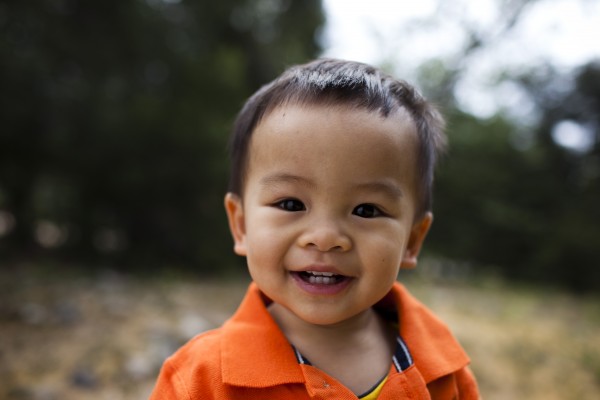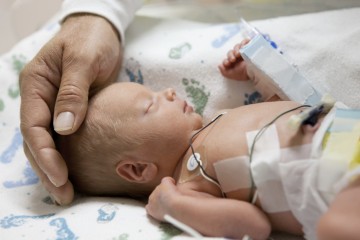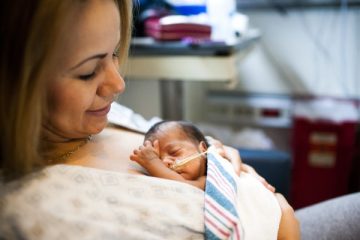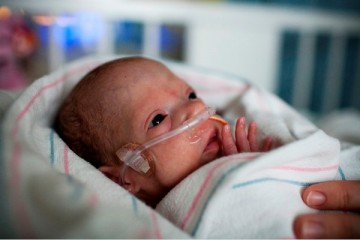Chronic Lung Disease of Infancy (Bronchopulmonary Dysplasia)
What is chronic lung disease of infancy (bronchopulmonary dysplasia)?
Chronic lung disease (CLD) of infancy, also known as bronchopulmonary dysplasia (BPD), is a form of chronic lung disease that affects mostly premature newborns and infants. It results from damage to the lungs caused by mechanical ventilation and long-term use of oxygen. Most infants recover from CLD, but some may have long-term breathing difficulty.
What causes CLD?
CLD results from lung injury to newborns from the use of a mechanical ventilator and extra oxygen for breathing. The lungs of newborn (and especially premature) babies are fragile and easily damaged. With injury, the tissues inside the lungs become inflamed and can break down causing scarring. This scarring can result in difficulty breathing and increased oxygen needs. Some causes of lung injury include the following:
- Prematurity – if the lungs, especially the air sacs, are not fully developed.
- Low amounts of surfactant (a substance in the lungs that helps keep the tiny air sacs open).
- Oxygen use (high concentrations of oxygen can damage the cells of the lungs).
- Mechanical ventilation – The pressure of air from breathing machines, suctioning of the airways, and use of an endotracheal tube. (ET tube is a tube placed in the trachea and connected to a breathing machine.)
What are the risk factors for CLD?
- Birth at less than 30 weeks gestation
- Birth weight less than 1,000 (less than 2 pounds) to 1,500 grams (3 pounds 5 ounces)
- Infant respiratory distress – lung disease of prematurity due to lack of surfactant
- Pulmonary interstitial emphysema (PIE) – a problem in which air leaks out of the airways into the spaces between the small air sacs of the lungs
- Patent ductus arteriosus (PDA) -a connection between the blood vessels of the heart and lungs that does not close as it should after birth
- Premature white, male babies
- Maternal womb infection (chorioamnionitis)
- A family history of asthma
- Breathing problems at birth
- Development of an infection during or shortly after birth.
What are the symptoms of CLD?
The following are the most common symptoms of CLD. However, each baby may experience different symptoms of the condition. Symptoms may include:
- Respiratory distress, such as rapid breathing, flaring of the nostrils, grunting, chest retractions
- Continued need for mechanical ventilation or oxygen after a premature baby reaches 36 weeks gestation.
The symptoms of CLD may look like other conditions or medical problems. Always consult your baby’s doctor for a diagnosis.
How is CLD diagnosed?
Because CLD is a chronic disease and appears gradually, doctors must look at several factors. It is often diagnosed when a premature baby with respiratory problems continues to need additional oxygen after reaching 28 days of age. Chest X-rays compared with previous X-rays may show changes in the appearance of the lungs. The X-ray of lungs with CLD often has a bubbly, sponge-like appearance.
Blood tests (test used to determine if enough oxygen is in the blood) and an echocardiography (test that use sound waves to create images of the heart to rule out defects) are also used to confirm causes of bronchopulmonary dysplasia.
Treatment of CLD
- Extra oxygen to make up for the decreased breathing ability of the damaged lung and a pulse oximeter to measure how much oxygen is in the blood.
- Mechanical ventilation with gradual weaning as the baby’s lungs grow and can do more of the work of breathing.
- Surfactant replacement.
- Medications such as bronchodilators, steroids, diuretics or antibiotics.
- Intravenous fluids and nutrition to help the baby and the lungs grow. It is important to monitor the fluid intake, because excess fluids can build up in the lungs and worsen the infant’s breathing ability.
- Radiant warmers or incubators to keep the infant warm and decrease the risks of developing an infection.
- Nutrition to help the baby and the lungs grow.
- Immunization against lung infection by RSV and influenza.
CLD can be a long-term condition. Some babies with CLD depend on mechanical ventilators for several months. Some babies will continue to need oxygen when they go home from the hospital. Most babies can be weaned from oxygen by the end of their first year. Babies with CLD may be at increased risk for respiratory infection and may need readmission to the hospitalized.

 The CHOC Early Developmental Assessment Center (EDAC) is a vital resource for families with children who were born early, had difficulties at or shortly after birth or have concern about their young child’s development. Consultation is available if our NICU or pediatrician has identified a concern.
The CHOC Early Developmental Assessment Center (EDAC) is a vital resource for families with children who were born early, had difficulties at or shortly after birth or have concern about their young child’s development. Consultation is available if our NICU or pediatrician has identified a concern. 













